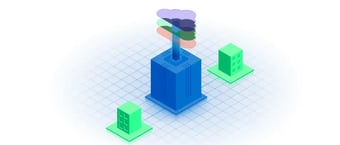
Smarter Government Starts with AI
Artificial intelligence has the potential to enable governments to deliver more cost-effective, modernized public services by accelerating digital transformation. Capitalizing on that potential brings challenges around security, cloud and network carrier interconnection front and center.

In early 2025, the so-called Department of Government Efficiency (DOGE) began reshaping American governance, the processes and systems that guide how citizens, agencies and entities providing government services interact. DOGE has implemented significant changes, including job cuts and policy shifts, sparking debates about the role of AI in public administration.
While the pace and impact of these reforms have been cause for debate, one thing is clear – governments are investing in the AI revolution. Artificial intelligence is not a tool just for the private sector – it’s rapidly becoming ingrained and essential for public life. From healthcare delivery and education to modernizing public aid and tax systems, state and federal agencies are exploring how AI can meet the rising demand for faster, more seamless and intuitive services for citizens.
With a $10 trillion opportunity for AI transformation on the table, according to the World Economic Forum’s GovTech Network, the stakes couldn’t be higher.1 Around the globe, governments are stepping into the AI era, not always perfectly and not without friction, but with a growing understanding that the future of governance will be digital, intelligent and citizen-first.
Government Public Service AI Use Cases
AI is being put to work for various agencies. In 2024, the U.S. government reported more than 1,757 AI use cases, more than double from 2023, illustrating how federal agencies are adopting the technology to enhance services and operations.3
From improving public safety to streamlining administrative processes, AI is becoming a vital tool for government efficiency and effectiveness. According to a Deloitte AI Institute report, the top uses for AI in the government include:
- Back-office Automation in Claims Processing: AI automates document digitization and data entry, speeding claims processing and reducing manual work in agencies such as the Department of Social Services.
- Population Risk Support: AI predicts risks related to homelessness, food insecurity and mental health, enabling policymakers to create targeted interventions to improve public welfare.
- Biomedical Data Science for Medical Breakthroughs: AI analyzes biomedical data to accelerate drug discovery, disease detection and personalized treatment, advancing medical research and clinical outcomes.
- HR Benefits Administration: AI improves HR processes by providing personalized benefit recommendations and analyzing employee engagement, increasing program efficiency and satisfaction.
- Health and Environmental Predictions: AI models predict disease outbreaks and monitor environmental changes, enhancing public health responses and tracking climate change impacts.
And the applications are growing. As capabilities expand, so does the potential to solve even more complex challenges.
The Digital Backbone of Government AI
None of this transformation happens in a vacuum. AI is only as powerful as the infrastructure it runs on. That’s where colocation data centers come in. These facilities can be the digital backbone of AI-powered governance, offering an environment supporting high-density workloads as well as the low-latency interconnection critical to mission outcomes and citizens’ online experiences.
Modern workloads are making liquid cooling capabilities a “must-have” for colocation providers. CoreSite data centers are equipped to provide liquid cooling and power that GPU-intensive workloads require, and our experience supporting high-density applications enables designing customized data center deployments ready for today’s and tomorrow’s use cases. Several of our data centers are part of the NVIDIA DGX-Ready Data Center program.
Training service-specific large language models (LLMs) in compliant “gov cloud” environments and then inferencing can happen more effectively leveraging colocation, especially with data centers adjacent to cloud availability zones and what CoreSite calls Inference Zones. Direct connections to public clouds also are significant; a dedicated connection is highly secure, can drastically reduce cloud costs, deliver scalable bandwidth and de-risk the overall IT environment.
Many agencies are losing personnel with technical expertise needed to run and modernize legacy infrastructure. Why not move that infrastructure into a data center and use digital tools to better manage it? You’ll be able to do more with less, retain control of systems and meet data governance requirements.
As federal, state and local agencies ramp up their AI ambitions, their reliance on high-performance, secure, interconnected data centers will only grow.
The Good, the Bad and the Unfinished Business of AI in Government
AI in government can be transformative. It potentially offers the kind of efficiency and responsiveness that citizens increasingly expect. According to a Deloitte study, AI could save the U.S. government more than $41 billion annually by streamlining administrative processes, freeing up time, reducing costs and allowing public servants to focus on higher-value work.3
The benefits go beyond cost savings. AI is accelerating research, improving public service delivery and enhancing national security by rapidly analyzing data to detect threats. In theory, it can help governments move faster and act smarter.
AI also introduces a new layer of complexity to public governance – one that can’t be resolved with code alone. Critics are alarmed by the potential for AI to reinforce systemic biases, mishandle sensitive data, or make opaque decisions that affect people’s lives. Replacing human oversight with algorithms raises significant questions about accountability, fairness and the potential erosion of democratic checks and balances.
AI in government holds tremendous promise – but only if it’s built on foundations of transparency, equity, and public trust. The challenge isn’t just adopting technology. It’s making sure technology is used wisely, with people – not just productivity – in mind.
Know More
Whether you are modernizing public services or preparing for AI in your enterprise, the foundation starts with a secure, purpose-built, interconnected data center.
Download "Government Goes Digital to Elevate New, Open CX - Citizen Experience" to learn more about how open data, digital transformation and government services are impacted by AI and your hybrid IT infrastructure.
References
1. How to ‘rewire’ governments to use AI in the Intelligent Age
2. The government and public services AI dossier
3. For AI to make government work better, reduce risk and increase transparency











